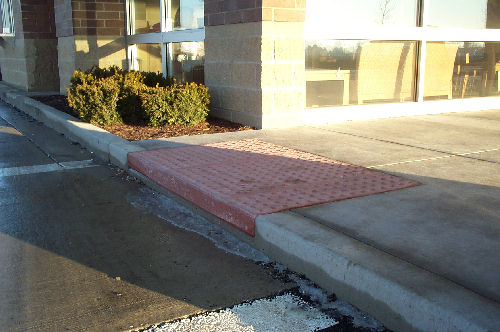
On a trip to an establishment in a neighboring city, I noticed the ramp shown above. Something did not look right, and upon further inspection, I realized the curb was not depressed. With the implementation of the final decision concerning ramp design, I have been trying to go out of my way to check out the ramps in other communities. I realized there has been some confusion and lack of knowledge concerning the regulations and requirements governing ramp construction, but I never thought I would see someone put in the detectable warnings but not depress the curb. What were they thinking while they were pouring the detectable warning pads?Â
I suppose someone could have thought that putting in detectable warnings prior to all roadway crossings, accessible or not, is a great idea. The problem is that due to the ADA regulation, people with reduced eyesight will reach this and expect a ramp with a depressed curb. This will confuse the pedestrian and could perhaps cause injury.
Clearly there is still a significant lack of training and education surrounding curb ramp construction. On publicly funded jobs, the engineer can be more involved and ensure that the requirements are being met. On privately funded projects where there may be no oversight by an engineer or architect, the owner is relying on the contractor to meet the requirements.
Last year, I was called to a new subdivision under construction because the developer was forming the public sidewalk and trying to conform to the ADA requirements that I had given him related to cross slope. A driveway had been poured from the private garage to the curb, through the area of the sidewalk, and the contractor for the homeowner had not met the ADA-mandated cross slope of 2% through the sidewalk area. The developer was having to match the nonconforming cross slope with his new sidewalk. I suggested he contact the driveway contractor to work this out. That driveway contractor called me and was extremely agitated. He felt it was the city’s responsibility to keep him informed about every federal, state, and local regulation that governed his work. Of course, it was all the city’s fault in his mind.  Â
I do think that public works professionals can educate to some degree but with reduced staff and funding at all levels of government, there is only so much we can do. There have been a few good articles published over the last year or so that are related to this subject:


